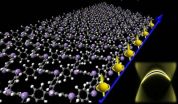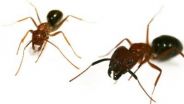(Press-News.org) CAMBRIDGE, MA -- Silicon, the material of high-tech devices from computer chips to solar cells, requires a surface coating before use in these applications. The coating "passivates" the material, tying up loose atomic bonds to prevent oxidation that would ruin its electrical properties. But this passivation process consumes a lot of heat and energy, making it costly and limiting the kinds of materials that can be added to the devices.
Now a team of MIT researchers has found a way to passivate silicon at room temperature, which could be a significant boon to solar-cell production and other silicon-based technologies.
The research, by graduate student Rong Yang and engineering professors Karen Gleason and Tonio Buonassisi, was recently published online in the journal Advanced Materials.
Typically, silicon surfaces are passivated with a coating of silicon nitride, which requires heating a device to 400 degrees Celsius, explains Gleason, the Alexander and I. Michael Kasser Professor of Chemical Engineering. By contrast, the process Gleason's team uses decomposes organic vapors over wires heated to 300 C, but the silicon itself never goes above 20 C — room temperature. Heating those wires requires much less power than illuminating an ordinary light bulb, so the energy costs of the process are quite low.
Conventional silicon-nitride passivation "is one of the more expensive parts, and one of the more finicky parts, in the processing" of silicon for solar cells and other uses, says Buonassisi, an associate professor of mechanical engineering, "so replacing part of silicon nitride's functionality with a simplified, robust organic layer has the potential to be a big win."
Essential process
Passivation is essential: Without it, silicon's surface is oxidized as soon as it's exposed to air, impeding its performance as a solar cell. "It would oxidize within minutes," Yang says. By contrast, the MIT team has tested silicon chips with the new polymer coating in place for more than 200 hours, observing no degradation at all in performance. "The electrical properties did not change," she says.
The low temperature of the silicon chip in this process means that it could be combined with other materials, such as organic compounds or polymers, that would be destroyed by the higher temperature of the conventional coating process. This could enable new applications of silicon chips — for example, as biosensors following bonding with compounds that react with specific biological molecules. "People have grafted DNA and protein antibodies to silicon," Yang notes.
Saving energy
The energy used in manufacturing silicon solar cells is a critical concern because every bit of cost savings helps to make them more competitive with other sources of electricity. The lower temperatures could significantly reduce manufacturing costs, the MIT researchers say.
The new process also has an added benefit, providing an anti-reflective coating that improves a solar cell's overall efficiency, the team says.
Both the conventional process and the new process take place in a vacuum chamber. Liquid reactants evaporate, then adsorb and react on the surface. The adsorption step is much the same as mist forming on a cold bathroom window after you take a shower.
The process can easily be scaled to the size of conventional solar cells, Gleason says. Additionally, the materials involved are all commercially available, so implementing the new method for commercial production could be a relatively quick process.
Buonassisi describes lowering the cost of manufacturing equipment, including that used to apply the passivating and antireflection coating, as "one of the three steps that's needed to drive down the price of solar modules to widespread grid competitiveness." (The other two are improvements in efficiency and reducing the amount of materials used.) The next step for his team is to scale up the process from laboratory-scale to production levels that could lead to commercialization, he says.
The challenge in making this advance, he explains, was found at the atomic level — specifically, at the interface between the organic coating material and the silicon, to ensure that the two bonded solidly. Tests have shown that the process this team developed has solved that challenge, Buonassisi says. While the team used one specific polymer for the coating, the process could be replicated using other organic materials.
### The research was supported by the Italian energy company Eni S.p.A., under the Eni-MIT Alliance Solar Frontiers Program.
Written by David Chandler, MIT News Office
A cooler way to protect silicon surfaces
New room-temperature process could lead to less expensive solar cells and other electronic devices
2013-02-13
ELSE PRESS RELEASES FROM THIS DATE:
Protein central to cancer stem cell formation provides new potential target
2013-02-13
HOUSTON - Researchers have identified a pivotal protein in a cellular transformation that makes a cancer cell more resistant to treatment and more capable of growing and spreading, making it an inviting new target for drug development.
Additionally, the international team led by scientists at The University of Texas MD Anderson Cancer Center found the cancer drug sunitinib potentially has a new role in treating triple-negative, claudin-low breast cancer, a particularly resistant version of a type of cancer that is already difficult to treat.
"We found that FOXC2 lies ...
NASA's Chandra suggests rare explosion created our galaxy's youngest black hole
2013-02-13
New data from NASA's Chandra X-ray Observatory suggest a highly distorted supernova remnant may contain the most recent black hole formed in the Milky Way galaxy. The remnant appears to be the product of a rare explosion in which matter is ejected at high speeds along the poles of a rotating star.
The remnant, called W49B, is about a thousand years old as seen from Earth and located about 26,000 light-years away.
"W49B is the first of its kind to be discovered in the galaxy," said Laura Lopez, who led the study at the Massachusetts Institute of Technology. "It appears ...
By guessing, clinicians may miss 3/4 of alcohol problems
2013-02-13
SAN ANTONIO, Texas (Feb. 13, 2013) — By relying on hunches rather than posing a few screening questions, primary care clinicians may be missing three-fourths of the alcohol problems in their patients, a newly released analysis shows.
"It's often off the radar — people come in for hypertension and are not asked how much they drink," said study co-author Barbara J. Turner, M.D., M.S.Ed., M.A., M.A.C.P., of UT Medicine San Antonio. Primary care offices typically don't have good systems to administer questionnaires to screen for certain problems, including alcohol consumption, ...
Tube versus IV feeding in malnourished pediatric cancer patients
2013-02-13
About 60 percent of pediatric cancer patients experience malnourishment during treatment. At that point, patients and families have a choice: tube feeding or IV nutrition supplement. Which would you choose? A study published this week in the Journal of Pediatric Oncology Nursing shows that families' perceptions, especially of the discomfort of tube feeding, leads to choosing IV over tube – despite the fact that tube feeding is usually the better choice, associated with better gut function and lower rates of infection.
"Despite the benefits of tube feeding, we found a ...
Key molecule suppresses growth of cancerous liver tumors, Mayo study finds
2013-02-13
ROCHESTER, Minn. -- A molecule already implicated in a number of diverse cellular functions can suppress the growth of tumors in the liver, a Mayo Clinic Cancer Center study has found. Its name is IQGAP1, and when the molecule is active in the cells that surround a tumor cell, this "tumor microenvironment" becomes less hospitable to cancer growth. When the molecule is deficient, cancer thrives.
Results of the study appear in the Journal of Clinical Investigation. The findings give new insight into cancer metastasis, the ability of a tumor to spread from its primary site ...
Engineers show feasibility of superfast materials
2013-02-13
SALT LAKE CITY, Feb. 13, 2013 – University of Utah engineers demonstrated it is feasible to build the first organic materials that conduct electricity on their edges, but act as an insulator inside. These materials, called organic topological insulators, could shuttle information at the speed of light in quantum computers and other high-speed electronic devices.
The study published this week in the journal Nature Communications will help pioneer a new field of research in materials science, in the same way organic materials lowered the cost and eased production of light-emitting ...
Epigenetics shapes fate of brain vs. brawn castes in carpenter ants
2013-02-13
PHILADELPHIA — The recently published genome sequences of seven well-studied ant species are opening up new vistas for biology and medicine. A detailed look at molecular mechanisms that underlie the complex behavioral differences in two worker castes in the Florida carpenter ant, Camponotus floridanus, has revealed a link to epigenetics. This is the study of how the expression or suppression of particular genes by chemical modifications affects an organism's physical characteristics, development, and behavior. Epigenetic processes not only play a significant role in many ...
Discovering cell surface proteins' behavior
2013-02-13
Contact:
Bingyun Sun, 778.782.9097, bingyun_sun@sfu.ca
Carol Thorbes, PAMR, 778.782.3035, cthorbes@sfu.ca
Simon Fraser University is Canada's top-ranked comprehensive university and one of the top 50 universities in the world under 50 years old. With campuses in Vancouver, Burnaby and Surrey, B.C., SFU engages actively with the community in its research and teaching, delivers almost 150 programs to more than 30,000 students, and has more than 120,000 alumni in 130 countries.
Simon Fraser University: Engaging Students. Engaging Research. Engaging Communities.
...
Southwest regional warming likely cause of pinyon pine cone decline, says CU study
2013-02-13
Creeping climate change in the Southwest appears to be having a negative effect on pinyon pine reproduction, a finding with implications for wildlife species sharing the same woodland ecosystems, says a University of Colorado Boulder-led study.
The new study showed that pinyon pine seed cone production declined by an average of about 40 percent at nine study sites in New Mexico and northwestern Oklahoma over the past four decades, said CU-Boulder doctoral student Miranda Redmond, who led the study. The biggest declines in pinyon pine seed cone reproduction were at the ...
Building a biochemistry lab on a chip
2013-02-13
Miniaturized laboratory-on-chip systems promise rapid, sensitive, and multiplexed detection of biological samples for medical diagnostics, drug discovery, and high-throughput screening. Using micro-fabrication techniques and incorporating a unique design of transistor-based heating, researchers at the University of Illinois at Urbana-Champaign are further advancing the use of silicon transistor and electronics into chemistry and biology for point-of-care diagnostics.
Lab-on-a-chip technologies are attractive as they require fewer reagents, have lower detection limits, ...
LAST 30 PRESS RELEASES:
General intelligence framework to predict virus adaptation based on a genome language model
Antibiotic resistance is ancient, ecological, and deeply connected to human activity, new review shows
Vapes, pouches, heated tobacco, shisha, cigarettes: nicotine in all forms is toxic to the heart and blood vessels
From powder to planet: University of Modena engineers forge a low-carbon future for advanced metal manufacturing
Super strain-resistant superconductors
Pre-school health programme does not improve children’s diet or physical activity, prompting call for policy changes, study finds
Autumn clock change linked to reduction in certain health conditions
AI images of doctors can exaggerate and reinforce existing stereotypes
Where medicine meets melody – how lullabies help babies and parents in intensive care
We may never be able to tell if AI becomes conscious, argues philosopher
AI video translation shows promise but humans still hold the edge
Deep ocean earthquakes drive Southern Ocean’s massive phytoplankton blooms, study finds
Without campus leftovers to pick through, the beaks of this bird changed shape during the pandemic
High-dose antibiotic does not reduce mortality in tuberculous meningitis
How many insects fly in the sky above the USA?
Could cheese protect your brain health?
Who faces more difficulty recovering from stroke?
Colliding galaxies create the brightest, fastest growing black holes at their center
New BrainHealth research reveals tradeoffs on sleep with cannabis use for chronic pain
Aging-US now on ResearchGate, enhancing visibility for authors and readers
'Molecular glue' stabilizes protein that inhibits development of non-small cell lung cancer
Mount Sinai Health System is recognized in 2025 Chime Digital Health Most Wired survey
From prey to predator: How carnivores spread beneficial fungi
Menopause symptoms may be frequent and have negative effects, according to female endurance athletes
US Congressmembers’ responses on X to mass shooting events differ along party lines
KAIST-UEL team develops “origami” airless wheel to explore lunar caves
Individual genetic differences render some therapies ineffective
Engineering dendritic cells boosts cancer immunotherapy
Sophisticated neuroimaging reveals PTSD in WTC responders is linked to measurable physical changes in brain structure
Health policy experts identify promising strategies for providing health care to homeless people
[Press-News.org] A cooler way to protect silicon surfacesNew room-temperature process could lead to less expensive solar cells and other electronic devices




